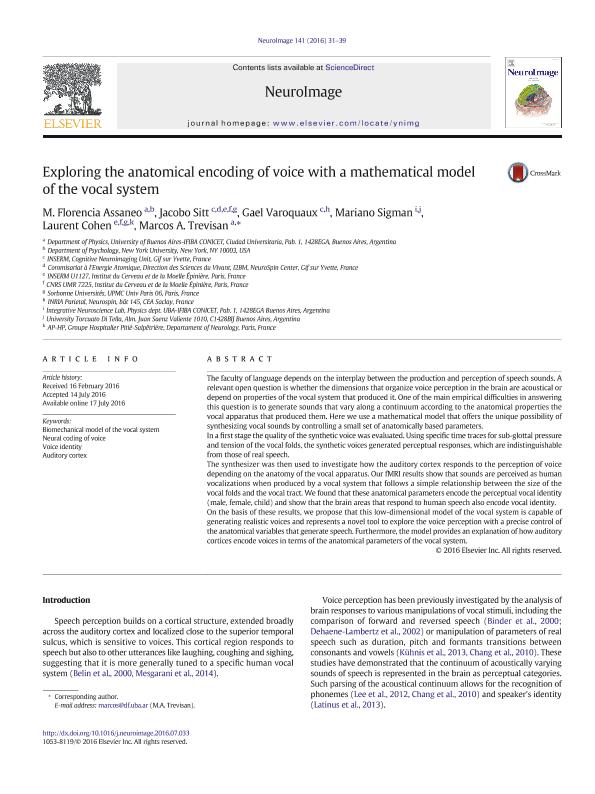Mostrar el registro sencillo del ítem
dc.contributor.author
Assaneo, María Florencia

dc.contributor.author
Sitt, Jacobo Diego

dc.contributor.author
Varoquaux, Gael
dc.contributor.author
Sigman, Mariano

dc.contributor.author
Cohen, Laurent
dc.contributor.author
Trevisan, Marcos Alberto

dc.date.available
2018-05-30T12:15:36Z
dc.date.issued
2016-11
dc.identifier.citation
Assaneo, María Florencia; Sitt, Jacobo Diego; Varoquaux, Gael; Sigman, Mariano; Cohen, Laurent; et al.; Exploring the anatomical encoding of voice with a mathematical model of the vocal system; Academic Press Inc Elsevier Science; Neuroimage; 141; 11-2016; 31-39
dc.identifier.issn
1053-8119
dc.identifier.uri
http://hdl.handle.net/11336/46562
dc.description.abstract
The faculty of language depends on the interplay between the production and perception of speech sounds. A relevant open question is whether the dimensions that organize voice perception in the brain are acoustical or depend on properties of the vocal system that produced it. One of the main empirical difficulties in answering this question is to generate sounds that vary along a continuum according to the anatomical properties the vocal apparatus that produced them. Here we use a mathematical model that offers the unique possibility of synthesizing vocal sounds by controlling a small set of anatomically based parameters. In a first stage the quality of the synthetic voice was evaluated. Using specific time traces for sub-glottal pressure and tension of the vocal folds, the synthetic voices generated perceptual responses, which are indistinguishable from those of real speech. The synthesizer was then used to investigate how the auditory cortex responds to the perception of voice depending on the anatomy of the vocal apparatus. Our fMRI results show that sounds are perceived as human vocalizations when produced by a vocal system that follows a simple relationship between the size of the vocal folds and the vocal tract. We found that these anatomical parameters encode the perceptual vocal identity (male, female, child) and show that the brain areas that respond to human speech also encode vocal identity. On the basis of these results, we propose that this low-dimensional model of the vocal system is capable of generating realistic voices and represents a novel tool to explore the voice perception with a precise control of the anatomical variables that generate speech. Furthermore, the model provides an explanation of how auditory cortices encode voices in terms of the anatomical parameters of the vocal system.
dc.format
application/pdf
dc.language.iso
eng
dc.publisher
Academic Press Inc Elsevier Science

dc.rights
info:eu-repo/semantics/openAccess
dc.rights.uri
https://creativecommons.org/licenses/by-nc-nd/2.5/ar/
dc.subject
Biomechanical Vocal Model
dc.subject
Neural Coding of Voice
dc.subject
Voice Identity
dc.subject
Auditory Cortex
dc.subject.classification
Otras Ciencias Físicas

dc.subject.classification
Ciencias Físicas

dc.subject.classification
CIENCIAS NATURALES Y EXACTAS

dc.title
Exploring the anatomical encoding of voice with a mathematical model of the vocal system
dc.type
info:eu-repo/semantics/article
dc.type
info:ar-repo/semantics/artículo
dc.type
info:eu-repo/semantics/publishedVersion
dc.date.updated
2018-05-29T21:12:28Z
dc.journal.volume
141
dc.journal.pagination
31-39
dc.journal.pais
Países Bajos

dc.journal.ciudad
Amsterdam
dc.description.fil
Fil: Assaneo, María Florencia. Consejo Nacional de Investigaciones Científicas y Técnicas. Oficina de Coordinación Administrativa Ciudad Universitaria. Instituto de Física de Buenos Aires. Universidad de Buenos Aires. Facultad de Ciencias Exactas y Naturales. Instituto de Física de Buenos Aires; Argentina. University of New York; Estados Unidos
dc.description.fil
Fil: Sitt, Jacobo Diego. Inserm; Francia. Universite de Paris VI; Francia. Centre de Recherche de I'institut Du Cerveau Et de la Moelle Epiniere; Francia. Consejo Nacional de Investigaciones Científicas y Técnicas; Argentina
dc.description.fil
Fil: Varoquaux, Gael. Inserm; Francia. Institut National de Recherche en Informatique et en Automatique; Francia
dc.description.fil
Fil: Sigman, Mariano. Consejo Nacional de Investigaciones Científicas y Técnicas. Oficina de Coordinación Administrativa Ciudad Universitaria. Instituto de Física de Buenos Aires. Universidad de Buenos Aires. Facultad de Ciencias Exactas y Naturales. Instituto de Física de Buenos Aires; Argentina. Universidad Torcuato di Tella; Argentina
dc.description.fil
Fil: Cohen, Laurent. Centre de Recherche de I'institut Du Cerveau Et de la Moelle Epiniere; Francia. Universite de Paris VI; Francia
dc.description.fil
Fil: Trevisan, Marcos Alberto. Consejo Nacional de Investigaciones Científicas y Técnicas. Oficina de Coordinación Administrativa Ciudad Universitaria. Instituto de Física de Buenos Aires. Universidad de Buenos Aires. Facultad de Ciencias Exactas y Naturales. Instituto de Física de Buenos Aires; Argentina
dc.journal.title
Neuroimage

dc.relation.alternativeid
info:eu-repo/semantics/altIdentifier/doi/https://dx.doi.org/10.1016/j.neuroimage.2016.07.033
dc.relation.alternativeid
info:eu-repo/semantics/altIdentifier/url/https://www.sciencedirect.com/science/article/pii/S1053811916303408
Archivos asociados
